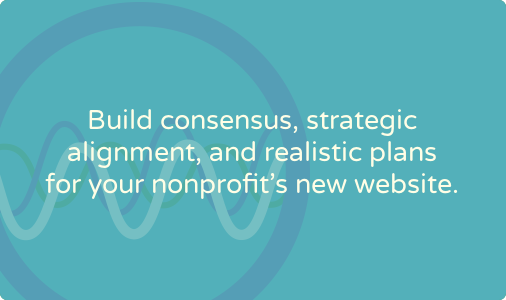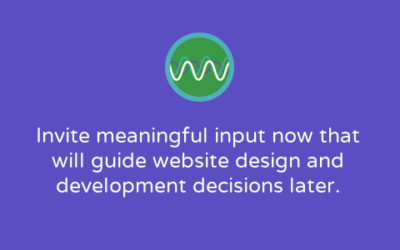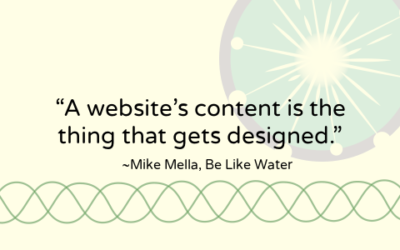This article was originally published on March 21, 2017, and updated on May 16, 2023.
You know the reasons why your nonprofit needs a website content strategy and how it will help you plan a new or redesigned site. You’re ready to put content first and benefit from a deliberate, strategic, planning process. So now that it’s time to develop it, what elements should you include in your nonprofit’s website content strategy?
There are many approaches to content strategy (and plenty of confusion between content strategy vs. content marketing). After doing this work for many nonprofit organizations over several years, I’ve narrowed in on the following decisions to document within a website content strategy to build consensus, strategic alignment, and realistic plans. And for this post, I’ve once again asked Mike Mella of Be Like Water to add his insights as a web designer and developer.
Are you ready to create a website content strategy for your nonprofit organization?
Document these elements in your nonprofit’s website content strategy.
Planning a solid website starts with strategic alignment —making and capturing decisions about your website’s purpose, audiences, messages and production.
1. Purpose
You should have more in mind than “we need a new site.” What do you want your new website — and therefore your website content — to achieve?
Your website exists to advance your organization toward achieving your vision and mission, so it needs to support the priorities in your nonprofit’s strategic plan and the business objectives of departments and program areas.
Measurable objectives
To support your nonprofit’s priorities, how can your website content encourage specific actions or engagement? Articulate the communications objectives for your website content, thinking about your audiences (see below) and the actions you want them to take on your site.
When you’ve defined what success will look like for your site, you’ll start to know the types of content you need and how each piece can support your objectives. These decisions will inform the calls to action you’ll feature in your website content. For example, if building your community of new and potential supporters is a priority, you might invite readers to subscribe to email updates. If you’re working to raise the profile of and participation in specific programs, you’ll invite readers to register.
From Mike:
“Some people think Web design is a form of art, but it’s really about problem solving. Every website should have an objective, and that should break down into smaller objectives per-section or even per-page.
Presenting your website to your visitors is not your goal; once a visitor arrives, your website’s job has only just begun. Make your website work for you. Decide what you want the visitor to do on every page. If a client gives me a plan that includes desired actions site-wide, I’ll have a head start at deciding how much visual weight to give each element. I can also plan to build in functionality that prompts the visitor to complete those actions, and allows them to do so easily.”
2. Audiences
Before making any content decisions, you must identify your priority audiences (yes, you’ll need to ditch the “general public”). Prioritize who you are trying to reach and serve via your website, going deeper into work you’ve previously done to identify and prioritize your nonprofit’s audiences. Consider each audience’s relative importance to the organization, the potential for impact, and how they use the website to obtain information and interact with you.
The number of audiences you prioritize will depend on your purpose and your organization’s size, scope, and complexity, but try to narrow this down as much as you can. Be honest about which relationships you will and won’t facilitate or strengthen through your site.
Audience personas
To give visitors what they want, you have to get to know them. So once you’ve identified your priority website audiences, enhance personas to include their website content and engagement wants and needs. Spend time developing and thinking about your audience to understand their motivations and priorities:
- Why are they visiting or landing on your site?
- What are their information wants and needs?
- What questions are they trying to answer?
- What tasks do they want to perform?
Exploring the answers to these questions increases the likelihood that you’ll create content they’ll read and act upon.
You’ll avoid making internally biased decisions when you’re clear and specific about your audiences. You must have your ideal visitors – not your board, senior management team or colleagues – at the forefront of your website decisions.
From Mike:
“The question of what you want to achieve should be answered not only for the site as a whole, but for each site section. I believe that every page in a site should have a defined call-to-action; something you want the visitor to do there. With this information, your developer can visualize the visitor’s experience as he/she navigates the site.
Creating personas for your audiences puts you and your developer on the same page as far as knowing how to present your website’s content. Everyone has the same clear examples of what your target audiences look like. Visualizing this helps your developer to present navigation or content in a way that’s appropriate for each visitor’s journey through the site.”
3. Messages
The information and insights about your website’s purpose and audiences will help you to shape your website’s messages; what your content needs to communicate.
Key messages
If your website was a person speaking to a member of your priority audience, what would you want it to say? Develop a one or two-sentence message for each website audience. Your strategic and business priorities should inform your website key messages, your audiences’ content wants and needs, your brand strategy and brand-level key messages.
From Mike:
“Articulating website key messages is a valuable exercise. Often we get caught up in the technical aspects of creating a website. Seeing your site as a person helps everyone involved in the project to remember its purpose: to deliver your message to real people.”
Voice and tone
In her article on the Neilson Norman group blog, The four dimensions of tone of voice, Kate Meyer states: “Tone of voice is the way we tell our users how we feel about our message, and it will influence how they’ll feel about our message, too.” Funny vs. serious? Formal vs. casual? Respectful vs. irreverent? Enthusiastic vs. matter-of-fact? Look at Meyer’s framework of four dimensions that you can use to analyze or plan your site’s tone of voice (she even includes examples illustrating how these dimensions can be applied to website copy.)
The voice and tone of your website content should reflect your organization’s specific brand personality. An established voice and tone will come in handy when creating, repurposing or editing existing content for your new site, and it will be a standard to point back to during future editing or approvals processes.
From Mike:
“Voice and tone can affect everything from font selection to colour scheme. What works for one organization may not work for another. This can be particularly important for micro-copy: the small (and often overlooked!) messages that assist the visitor while engaging with the site, like the thank you message displayed after submitting a contact form. Some websites have a more serious tone than others, and it’s important to consider this when crafting those messages.”
Content categories and topics
Use the work you’ve done so far to determine the priority content categories (or “buckets”) and the specific topics you’ll need to feature on your new site to:
- Explain your cause or issue
- Describe your organization, your approach and the programs and services you offer
- Invite people to support your work and get involved
- Introduce your people, partners and other supporters
- Showcase your vision and impact
Plan your content in stages. What will you produce, revise and repurpose to launch your new site? What will you develop over time to grow and enrich your content?
From Mike:
“I often say there’s no such thing as a small website, because the nature of a website is to grow. Establishing priority topics helps you and your Web developer to see the “big picture” of how your site will grow over time, where it’s headed, and what’s needed to get it there.”
4. Production
As you build your strategy, make production decisions. You’ll ensure your website plans are realistic by thinking about content creation, maintenance, and your organization’s capacity.
Content types
What shape will your content need to take, and what formats will you use to deliver it? Consider the elements you’ll need, including basic pages, landing pages, index pages, sidebars, etc.
Roles, responsibilities, and resources
How will you create and maintain the content you are identifying and planning? What are your available content creation resources (including budget and time), and who is responsible? Document the people who will need to be involved, including content creators, internal subject matter experts, reviewers, and approvers.
Schedules and timelines
Create high-level content timelines and deadlines for production. Align these plans with existing editorial and other calendars (e.g., for newsletters, other publications, events, and campaigns).
In your website content strategy, you’ll capture high-level production decisions. Once your website content strategy is finalized and approved, you can start building a detailed website content project plan.
What elements will you include in your nonprofit’s website content strategy?
You can use the website content strategy elements I’ve recommended to get organized, get consensus, create strategic alignment and make realistic plans for your new site. You might choose to adapt or omit elements – or introduce others that would be helpful for your team. And if you’d like my help, see my nonprofit website content strategy package and contact me.




